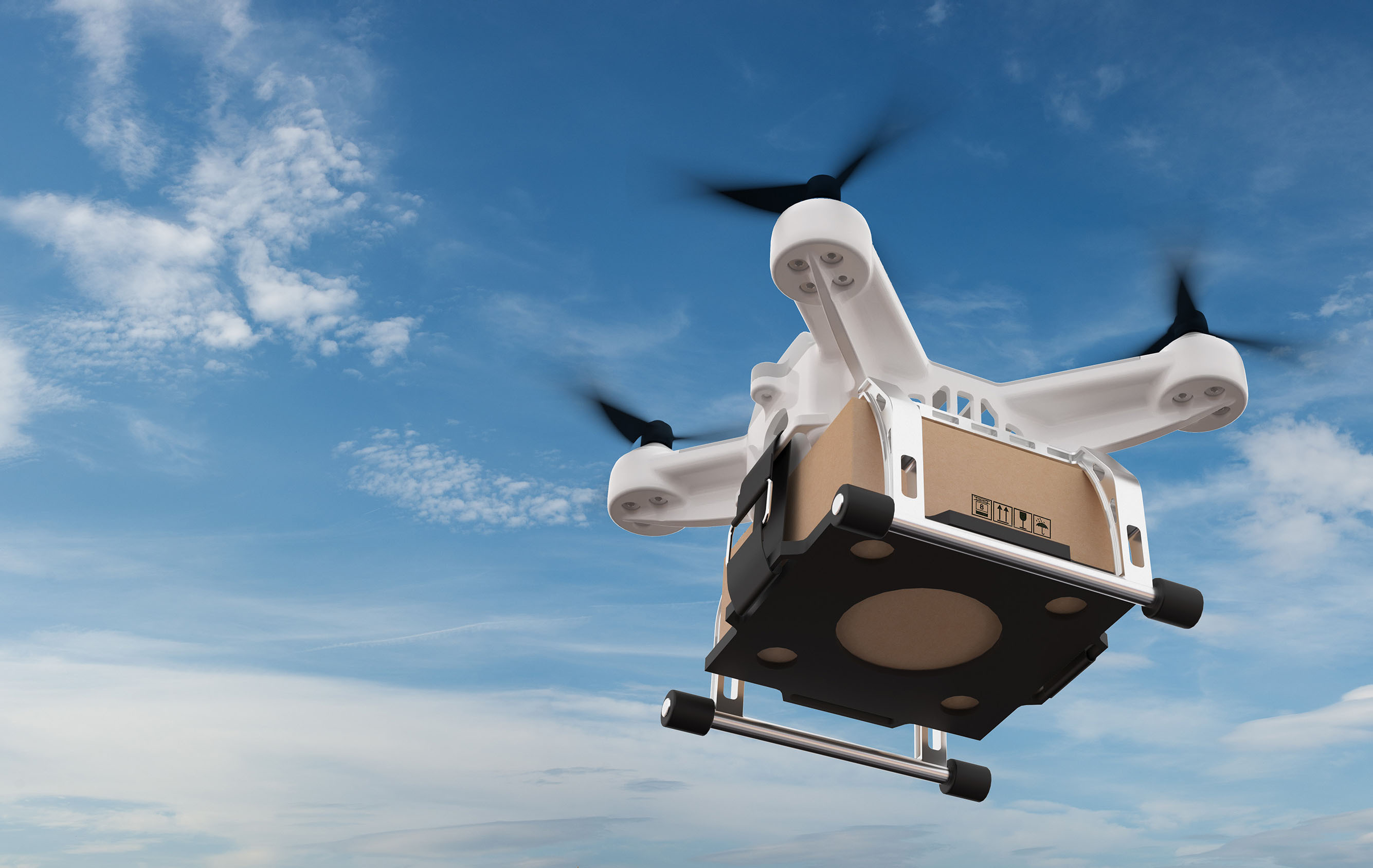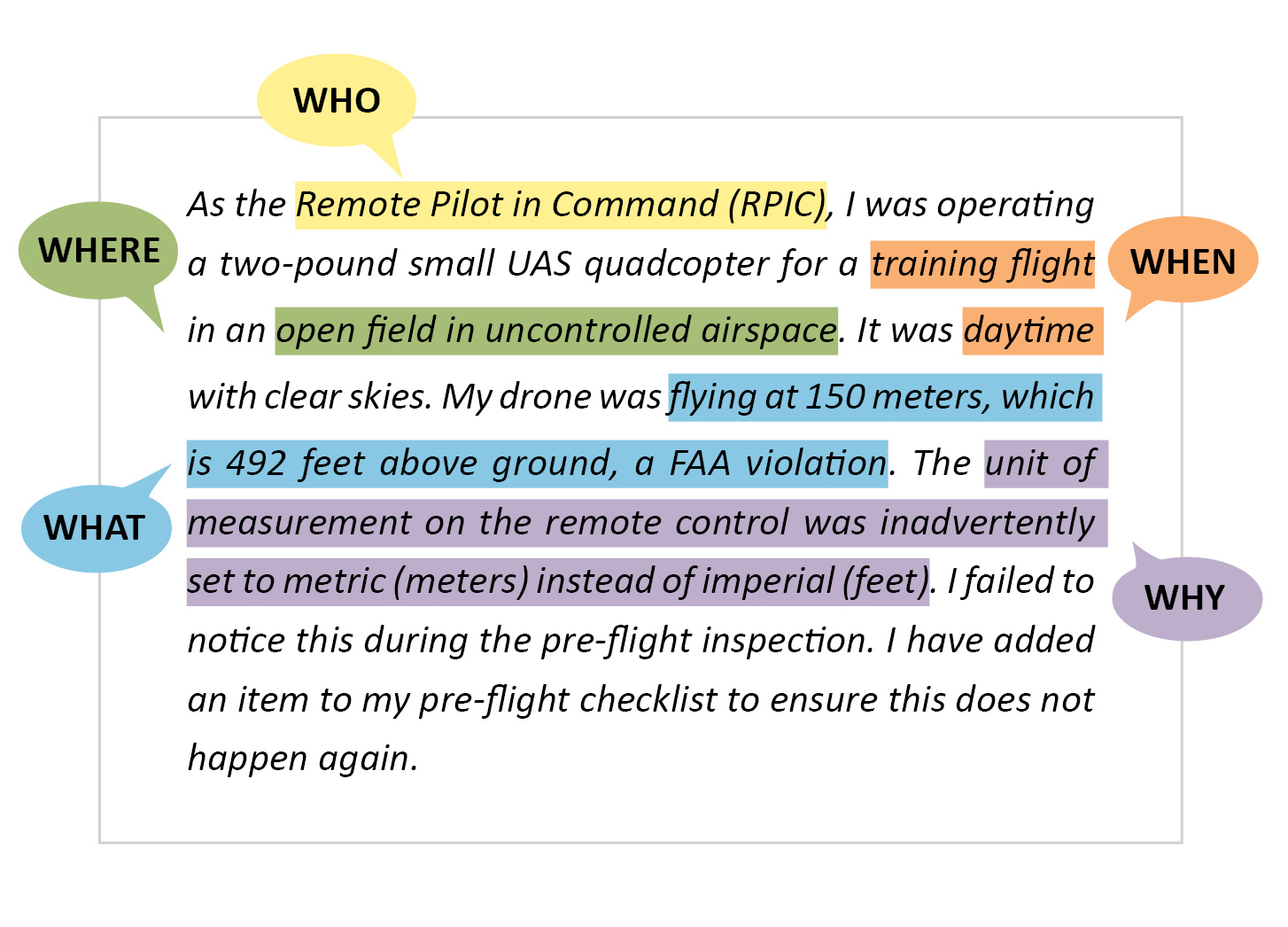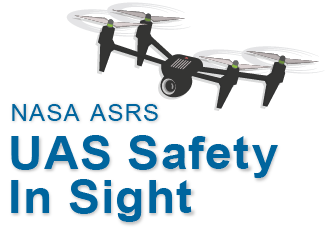UAS Safety
Reporting
From NASA's Aviation Safety Reporting System


 Recreational Flyers
Recreational Flyers Part 107 Crews
Part 107 Crews Public Operators
Public Operators Part 135 Operators
Part 135 OperatorsASRS welcomes reports about close calls and incidents such as:
- Collision or Near Mid Air Collision with another UAS/Drone, Aircraft, or Object
- Equipment Issues (hardware / software / automation)
- Lost Link
- Fly Away
- Uncontrolled Descent
- Airspace Incursions (e.g. Flying too close to an airport)
- Environmental Hazards
- Miscommunication
- Procedural Issues
- Human Error / Mistakes
- Injuries
-
The following should not be reported to the ASRS program
- Accidents
- Criminal Activity
The information you provide is kept CONFIDENTIAL
The ID strip containing your name, address, phone number is removed and sent back to you by mail as proof of submission. Your report is deidentified and personal references are removed and dates / times / locations are generalized. NASA will not reveal your identity.
When in doubt, fill it out! CONTRIBUTE to aviation safety
Share lessons learned with other UAS/Drone operators to prevent accidents and help make operations safer. The FAA offers protection against civil penalty and certificate suspension in exchange for your valuable safety information (see FAA Advisory Circular AC 00-46F).
NASA ASRS UAS Video – Your safety story counts!
Watch and share this short eight-minute video to learn how to submit a UAS/Drone safety report to NASA ASRS, how we process reports at NASA, how to search our database, and how to sign up for our newsletter.
ASRS FAQs
The ASRS is a voluntary, confidential, non-punitive, safety reporting system that receives safety reports from pilots, air traffic controllers, dispatchers, cabin crew, maintenance technicians, and now UAS/Drone operators.
ASRS has been a part of the aviation safety culture for over 45 years and has collected and analyzed over 1.7 million safety reports to date. These reports describe unsafe occurrences, hazardous situations, and lessons- learned to help prevent others from making the same mistake.
All reports are held in strict confidence and de-identified by ASRS safety analysts. The resulting anonymous aviation safety data is shared with the aviation and UAS/Drone communities.
An ASRS report form includes three sections:
Return Receipt (ID Strip)
In this section we ask for your name, address, and phone number. NASA may use the contact information to get in touch with you if additional information about the event is needed. The ID Strip is then removed and will be mailed (via USPS) to you as proof that your report has been processed. NASA does not retain any personal information provided on the ID Strip. You may need to show the ID Strip as proof of submission, so keep it in a safe location.
Event and Operational Information
This section asks for background information and general event characteristics such as weather, location, and details about your UAS/Drone equipment. Answer these questions as best you can, but it is ok to leave a question blank if it does not apply.
Narrative
This is a section for explaining what happened in your own words and any safety lessons you may have learned from the experience. Provide enough details to answer: WHO was involved, WHAT was the event, WHERE did it occur, WHEN did it occur, WHY do you think it happened and HOW could this event be prevented in the future? Also, be sure to include any relevant details about your UAS/Drone such as the radio frequency or when you last updated the software.
There are many reasons to provide information about the event or situation that you experienced. NASA and other members of the aviation and UAS/Drone community are committed to improving aviation safety. Through conducting research and analysis of reports, ASRS can share:
- Lessons learned which can help prevent others from making the same mistake.
- Best practices for procedures, checklists, and safety briefings to support safe operations.
Your information may also be used to identify equipment, software, and automation issues that can contribute to incidents and resolve these issues to improve safety.
The FAA offers protection against civil penalty and certificate suspension in exchange for filing an ASRS report as this is indicative of a constructive attitude which will tend to prevent future violations (see Advisory Circular AC 00-46F). However, reports regarding accidents and criminal acts such as reckless endangerment, criminal mischief, or voyeurism are excluded from the protections offered by the FAA. You can report to ASRS at any time, but in order to receive protection from the FAA, your report must be submitted within 10 days of the event, or when you first became aware of the event.
- The report is de-identified to protect your confidentiality. Names, dates, and times will be removed or generalized, and any other identifying information will be removed or de-identified.
- NASA ASRS Expert Analysts may call you to obtain additional information to help us understand the safety issue.
- NASA ASRS will remove the Identification (ID) Strip at the top of your report, date stamp it, and return it to you by U.S. Mail.
- Retain the ID strip as your proof of report submission.
You have two secure options to submit your report. Click on either icon below to get started.
Providing detailed and complete reports is vital to making the UAS/Drone community and National Airspace safer. To ensure you are submitting a report that would result in a safety improvement, ask yourself:
- Does my identification strip provide adequate contact information?
- What was the type of event / situation?
- When did it happen?
- What was my involvement in the event? Anyone else involved?
- What was my location at the time of the event? Where was my UAS/Drone?
- What was the operating environment at the time of the event (e.g., weather, light)?
- What type of airspace was I operating in?
- Is there enough information about the UAS/Drone involved in the event?
- What were the contributing factors?
- Does my event / situation description tell the whole story?
- What was the result?
- Have I provided ideas for corrective actions?
EXAMPLE REPORT WITH INSUFFICIENT INFORMATION:

EXAMPLE REPORT WITH EXCELLENT INFORMATION:

Stay connected and sign up for the ASRS UAS/Drone newsletter highlighting emerging safety topics.
Sign Up
Read Previous Issues
Questions or feedback?
Do you have more questions about UAS/Drone Safety Reporting or feedback about the UAS/Drone report form? Contact Us
Webmaster: Mariana Carmona | NASA Official: Becky L. Hooey
NASA ASRS | NASA.gov | NASA Ames | Privacy | Accessibility
